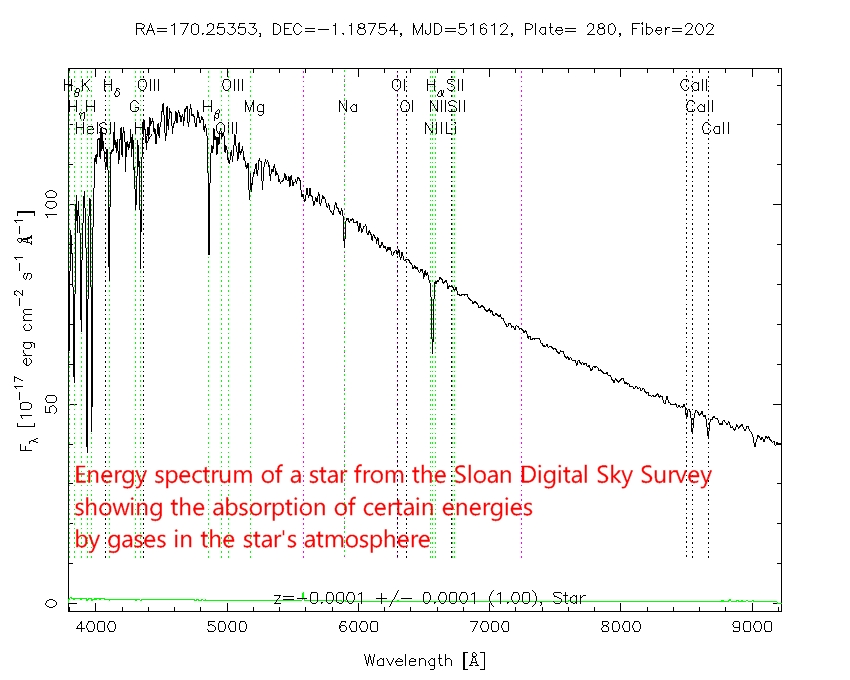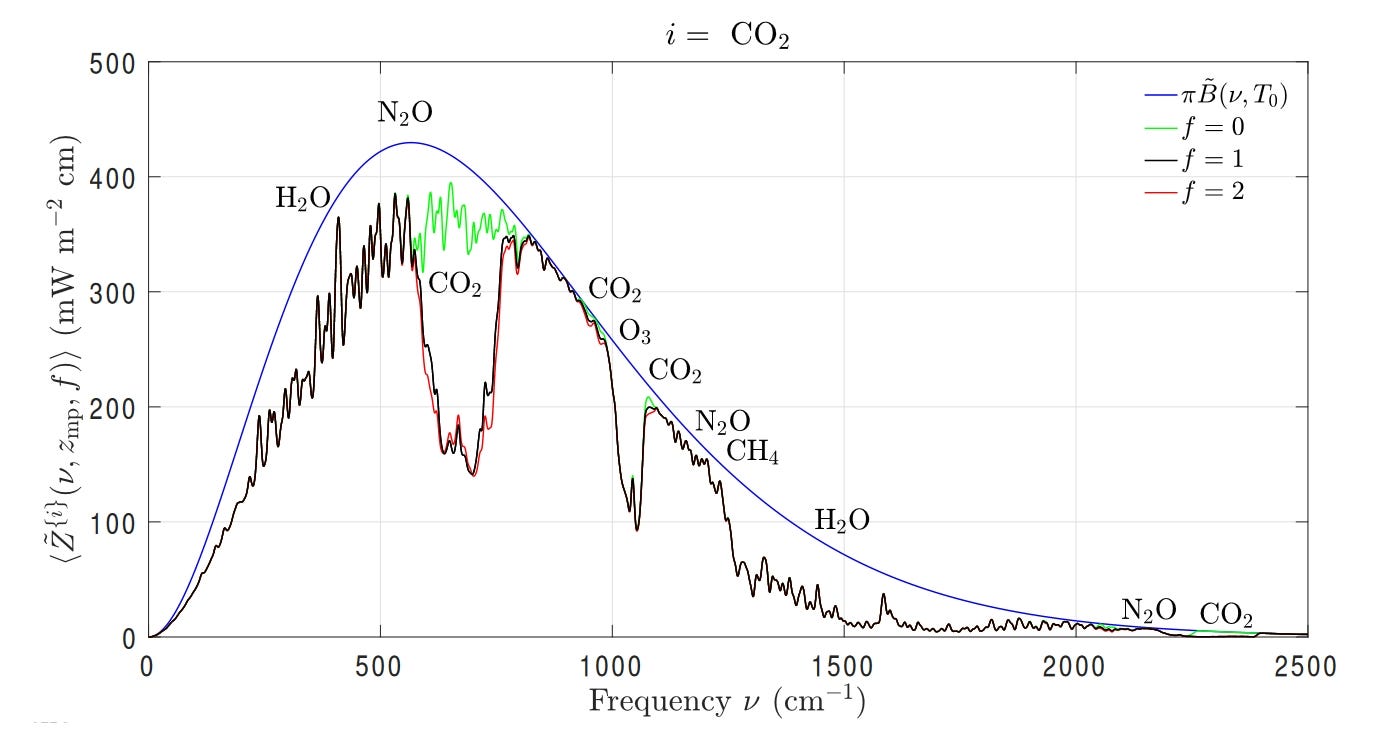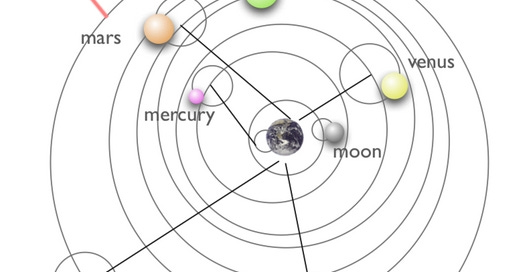It's nearly two years since I started writing this series on panocracy and I've had a couple of diversions in the last seventy-odd chapters.
This time I thought I'd take a break from preaching about the benefits and challenges of a real democracy and instead preach to you, dear reader, on the subject of Climate Change.
So an obvious place to start is with the Ptolemaic System of Cosmology. My apologies if you already know this but it does have some relevance as we shall see later.
The Ptolemaic System was invented around 150AD in Alexandria, Egypt. It was an ingenious way of accounting for the observed motions of the sun, the moon and the planets across the sky.
The starting assumption was the prevailing view that the Earth is at the centre of the Universe and the sun, moon and planets revolve in circular orbits around it. As God's creation, Earth and all God's creatures must be at the centre of everything. A circle was taken to be perfect and so, the theory went, God must have used them in building His creation.
It worked pretty well for a while but eventually began to show cracks as observations improved – for example Mars sometimes seemed to briefly reverse direction.
To 'save' the idea of circular orbits circular 'epicycles' were added so the planet would make an extra little circle around its own big circle and this accounted for the planetary back pedalling.
As measurements improved further, sub-epicycles and sub-sub-epicycles were added to fit the theory to the new observations.
The Ptolemaic system of course found favour with religious dogma as it put the mankind squarely at the centre of creation.
It all broke down eventually when trying to explain the motion of comets and the moons of Jupiter. and we – with much pain - got the modern model from Brahe, Copernicus, Kepler, Galileo and Newton.
The relevance of this will become clear later, I promise.
Truth and Clarity
I had hoped this would be short but, as Niels Bohr put it: truth and clarity are complementary.
Climate Change is a hot topic these days with our western technocracies racing to outdo each other in their virtuous clamp downs on all things non-renewable.
My intention is to state my current position on Carbon Dioxide (CO2) and its impact on climate change and global warming. It has turned out to be more technical than I expected so I hope you, dear reader, are not discouraged in reading it.
My approach here is to talk about basic physics that is well-established rather than give a list of who says what.
Everyone has now to take a position on climate change because we all have to make decisions about how to run our lives: do I believe what I'm being told enough for me to change my lifestyle, abandon my principles or hand my relatives over to the inquisition?
I'm not a climate scientist but I can read and interpret (with some effort!) what scientific papers are saying and that's what follows.
We're going to firstly and briefly review the current state of play. Then we'll look at some basic Physics in relation to CO2. After that we'll review a more sophisticated model of our atmosphere and its composition and see what conclusions have been drawn from it. Finally we'll remind ourselves that none of this is cast in concrete and that new results and ideas can come up at any time.
So buckle up, it's going to be a bumpy ride.
The Climate Landscape
Let me say firstly that most of us get the idea of not polluting our planet with long lived piles of plastic and other products of the consumer society. Having eaten up the propaganda of the late 20th century I and my immediate family have - for 30 years at least - done our very best to reuse and recycle. As a Scotsman I am naturally mean (we say canny here, by the way) and aim to get the most use for the smallest outlay. Sadly the planet remains unsaved in spite of our efforts.
Secondly, I struggle to think of anyone who does not believe that the Earth's climate changes on timescales from a few years to millions of years. The controversy is of course about how much of it is down to the human race.
Thirdly, it's obvious that our fossil energy reserves are finite so at some point in the future we will, if still confined to this blue ball in space, run out of them. Maybe this will be the distant future but finite means exhaustible. Anyhow, it would be wise to keep some fossil reserves for our descendants who may be here in the next ice age.
Fourthly, despite what various luminaries want to tell us, many issues in this area are still the subject of scientific debate. The science is most certainly not settled (it never is). This is because of the mind-numbing complexity of Earth's climate system which confounds the application of phenomenological climate models.
Most people don't have the time, the technical savvy or the inclination to examine the scientific arguments. They are therefore at the mercy of vested interests and pundits to interpret any scientific findings for them. This is a situation that has always applied but is now much more intense with modern technology, marketing and communications. There's no doubt that the scare-mongering has been ramped up with terms like 'global boiling' bandied about. People, especially if they're fearful, are apt to believe just about anything.
If you search for CO2 related information on the internet, it's very likely that you will be directed to the many sources which support the anthropogenic global warming hypothesis. Sources that don't are generally relegated to later results pages. A whole multi billion dollar industry has sprung up to keep an eye on atmospheric CO2 concentration which we are encouraged to believe is a proxy for global temperature. We will address this next.
Widespread use of emotive terms like 'denier' or 'hysteric' in the climate controversy suggests that it's more about religious belief than rational debate. The certainty with which the mainstream trumpets its case adds weight to this hypothesis. No Christian ever doubted the virgin birth.
This matters because policy is being created that can cause our economic situation – which means our current and future health and well-being– a lot of damage if it turns out to be wrong.
The term iatrogenic may turn out to be useful in areas outside medicine.
Some Physics
OK, it gets a bit more technical here but I urge you to read on. Please raise any questions in the comments. Remember there is no such thing as a silly question (but the world is littered with silly answers).
Back in 1896, inspired by the earlier ideas of Irish physicist John Tyndall, the Swedish physicist Svante August Arrhenius (Arrhenius, S., 1896. On the influence of carbonic acid in the air upon the temperature of the ground. Philos. Mag. J. Sci. 41, 237–276. .) (Carbonic Acid rapidly converts to CO2 and water if it's dissolved in water) suggested that gaseous CO2 emitted by industry might eventually accumulate in the atmosphere and cause a runaway greenhouse effect.
The greenhouse effect is where heat energy is trapped by some container (like a greenhouse whose glass doesn't transmit much heat to the outside). Hotter ground, heated by light from the Sun that isn't absorbed, means a rising atmospheric temperature as the container – layers of greenhouse gases that circle the globe in our case - stops the heat getting out.
Arrhenius made a calculation for doubling the CO2 in the atmosphere, and estimated it would raise the Earth's temperature some 5-6°C.
This view of the greenhouse effect was assumed to be correct for a few years until another Swede, Knut Johan Ångström, pointed out (in German) that there is a 'knee' beyond which increasing the concentration of CO2 will not really increase by much the absorption of energy by CO2.
It's a law of diminishing returns: adding more and more cause (i.e. CO2) has an ever-diminishing increase on the effect (i.e. warming) and that's called saturation.
Various others have refined these results in the intervening century and this has perhaps exaggerated the profile of CO2 in climate science relative to the roles of other greenhouse gases like water vapour, the Sun, Milankovitch cycles, volcanoes, space 'weather' and maybe other currently unknown factors.
So the first thing to realise is that a gas absorbs only a small proportion of the energy that impinges on it. If you look at the spectrum of a star, you will see a number of 'dips' where a gas in the star's atmosphere has absorbed that particular energy.
And as in the case of planetary motion, the laws of physics are general enough to apply equally to both stars and planets in particular when it comes to energy being absorbed by their atmospheres. The temperature ranges are different but the laws are the same.

The next thing to know is that the gas re-radiates the absorbed energy across a broad spectrum.
On the molecular scale, energy absorption happens when an incident photon (unit of energy) kicks an electron in a gas molecule into a higher energy state. This requires a photon of a very specific energy (or equivalently frequency or wavelength). That higher energy electron wants to get back to a lower energy state but it's not restricted to going back by the same route – it can jump into intermediate energy states by emitting several photons of smaller energy until it returns to the energy state it had at the start. Those photons are not absorbed by the surrounding gas molecules as they're not of suitable energy.
This leads to the phenomenon of saturation as noted by K J Angstrom in which increasing the gas concentration doesn't significantly increase the gas's energy absorption.
Saturation has the effect of broadening the absorption lines – in other words the gas becomes able to absorb a wider range of energies.
The calculations for this become very complex and onerous but as we will see below they have been carried out.
In a rather ingenious experiment Kulbicki and co-workers, showed in 2024 that radiation from the Moon (whose sunny face is at 110C compared to 15C for Earth) is not absorbed by a volume of CO2 at ground level after having passed through the Earth's atmosphere. The CO2 in the upper parts of the atmosphere soaked up all the relevant energy from the heat source (the Moon) so adding another layer of CO2 to the atmosphere wouldn't absorb any more energy and heat up.
(Climatic consequences of the process of saturation of radiation absorption in gases by Jan Kubicki , Krzysztof Kopczynski , Jarosław Młynczak Institute of Optolelectronics, Military University of Technology, Kaliskiego 2, Warsaw 00-908, Poland)
This isn't conclusive and it would be interesting to see the experiment repeated high up where the atmosphere has a lot less CO2. But it does confirm that saturation occurs in our atmospheric CO2.
A Bigger Picture
So now we've got some basic ideas we need to look a bit deeper.
As I mentioned above calculating the absorption of heat energy by CO2 and other atmospheric gases is monstrously complicated and requires lengthy and detailed computation. Fortunately we have computers now that Aarhenius and Angstrom could only dream about.
Wijngaarden and Happer presented a detailed calculation of the absorption of heat radiated from the Earth's surface by 5 greenhouse gases in the atmosphere: H2O (water vapour), CO2 (carbon dioxide), O3 (ozone), N2O (nitrous oxide) and CH4 (methane).

They used a well-known molecular spectroscopic database called HITRAN (High Resolution Transmission). This database details the absorption characteristics of many atmospheric gases as measured in the laboratory. Wijngaarden and Happer added together the effects of absorption and retransmission of heat energy over the range and amplitude of energies emitted by the Earth's surface.
As you might guess, this is a big calculation but it's just applying the basic physical principles we saw earlier lots and lots of times over and over again.
They arrived at a complex relationship (see graph above taken from the paper) which closely duplicates the values actually measured from space for the Earth's thermal radiation. In other words the shape of the spectrum that is observed from satellites after absorption by the atmosphere is very close to what Wijngaarden and Happer's calculations - from the known properties of gases - predict.
This should give us confidence that their model is close to reality.
The blue line on the graph is what would be observed if the atmosphere were transparent to heat energy; the black line is what is predicted (and observed) for the current temperature of the atmosphere. As you can see water vapour (H2O) typically absorbs energy at lower and higher energies while the big dip in the middle is due mainly to CO2.
Note that much less energy would escape into space were it not for the saturation that we talked about earlier.
The green line is what we would observe if there were no CO2 in the atmosphere and the red line shows the calculation if its concentration were to double to around 0.08%.
The difference in atmospheric temperature between the black and red lines works out to be 0.7C according to Wijngaarden and Happer. So if we somehow doubled the concentration of CO2 in the atmosphere its temperature would rise by 0.7C.
Climate Models
If you've got this far … well done! Award yourself a trip to the Maldives.
We've looked into CO2 in some depth and discovered the phenomenon of saturation and how it breaks the naïve greenhouse arguments. This shouldn't really be a surprise.
For the last 4.5 billion years Earth's climate has been affected, sometimes grossly, by many natural factors. The Earth has frozen in ice ages and baked in balmy interglacials - its atmospheric CO2 has mushroomed to levels far higher than we humans could probably raise them and collapsed to levels so low that plant life struggled to survive.
But here we are - alive and kicking, the predictions of the doomsayers on thermal runaway and global catastrophe unrealised despite the CO2 levels being far higher in the past.
Now we know why.
Ptolemy Revisited
To go back to the Ptolemaic System that we saw at the start, where new epicycles and sub-epicycles were added to fix the theory to fit the data, we can see that climate science is something of a rerun: we start with an assumption that CO2 is the primary cause of global warming and make up models that fit the current observations.
When new observations come in researchers tweak their models – just like epicycles and sub-epicycles – to fit the new data.
Good science has breadth, precision and predictive power: Newton's Laws tell us about motion well enough to fly spacecraft to Pluto and not crash into it. They have also been used to predict the orbits of previously unknown planets and heaven knows how many other useful things.
So when 2023 was observed to be the 'hottest year ever' and climate models completely failed to predict it, we have to question the methodology and the assumptions on which they're founded. The CO2 based climate models are falsifiable and have now been falsified.
The physics we saw above tells us why.
We saw also how the physics of stellar atmospheres is the same as the physics of the Earth's atmosphere and how using such physics without additional assumptions gives a very good description of what we observe in the atmosphere.
Since we can rely on basic physics, we can be confident that we could add lots more CO2 to the atmosphere without fear of climate catastrophe.
I'm not suggesting that we deliberately should but it gives us time to plan properly for a sustainable future. We can afford to wait while 'green' technologies that actually work are developed.
Let's not give in to panic and ruinous policies yet again.
Well that's what I think. What about you?





So, all of this is correct. It's also... less useful than one would hope when talking to the public.
So I've boiled it (ha!) down to some much more simple claims.
1.) CO2 is plant food.
2.) Plants grow when it's warm, not when it's cold.
3.) The majority of landmasses are in locations where winter warming above current levels would result in vastly increased levels of *human* food production.
The people preaching this religion don't actually act as though they believe it. They know it's a scam intended to subjugate the masses.
I'm quite tired of it.
I read that oil is abiotic (unlike fossil coal) and that the earth continually produces it, although an oil well can temporarily run dry if the amount removed is at too great a pace for the earth to replace at the same rate as the extraction. So maybe we don't need to panic at all?